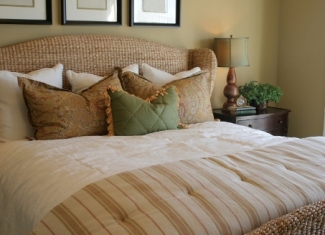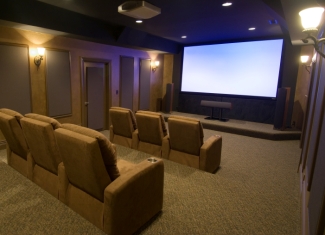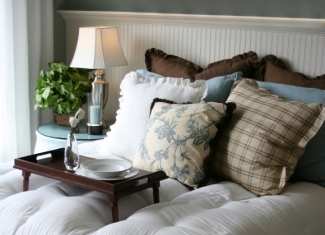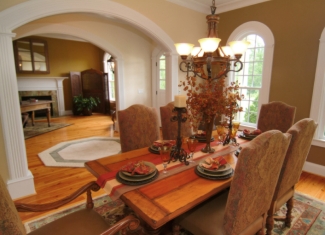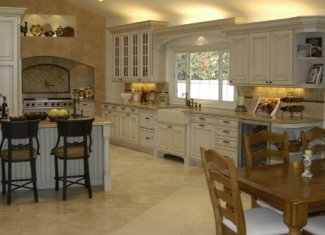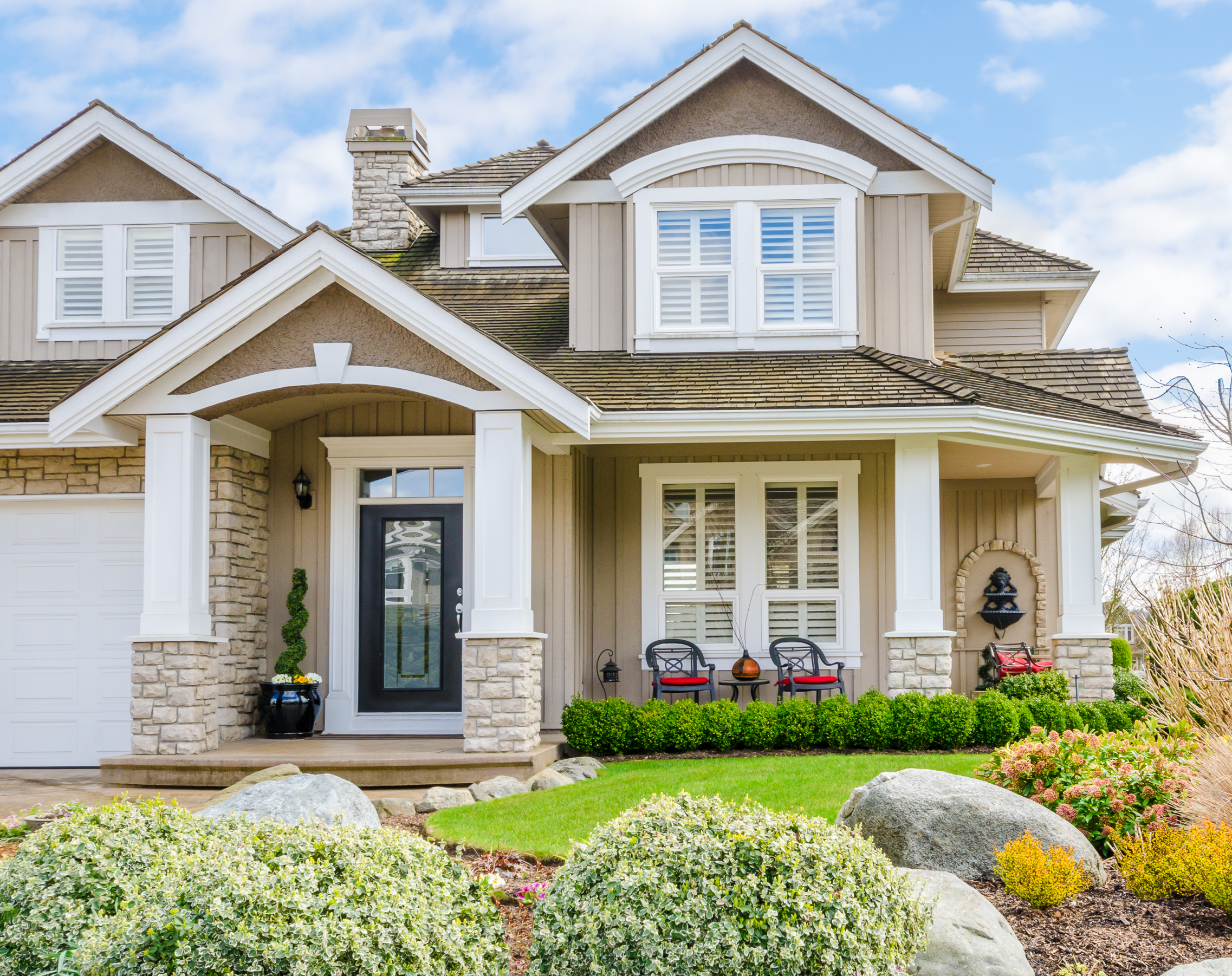Window Treatment Ideas for Home Decorating
Natural light has the power to transform any space, making it feel larger, brighter, and more inviting. With the right window treatments, you can harness the beauty of natural light while adding style and functionality to your home decor. In this guide, we’ll explore various window treatment ideas designed to maximize natural light and elevate the ambiance of your living spaces.

Sheer Curtains
Sheer curtains are an excellent choice for maximizing natural light while still providing privacy and softening harsh sunlight. These lightweight fabrics allow sunlight to filter through, creating a luminous and airy atmosphere. Opt for sheer curtains in neutral tones like white, ivory, or light gray to maintain a bright and open feel in your space. Pair sheer curtains with heavier drapes or blinds for added versatility and control over light levels throughout the day.
Roman Shades
Roman shades offer a sleek and stylish alternative to traditional curtains or blinds. These fabric window treatments fold neatly when raised, allowing ample natural light to flood into the room. Choose light-colored or patterned Roman shades to complement your decor while brightening up the space. For maximum light exposure, consider installing Roman shades in a relaxed, unlined style that allows sunlight to penetrate through the fabric.
Solar Shades
Solar shades are designed to block harmful UV rays and reduce glare while still preserving outdoor views and natural light. These innovative window treatments feature a specialized mesh fabric that filters sunlight, making them ideal for rooms with expansive windows or high sun exposure. Select solar shades with varying levels of opacity to customize the amount of light and privacy desired in each space. Install solar shades in sun-drenched areas like living rooms, kitchens, or home offices to create a comfortable and glare-free environment.
Top-Down Bottom-Up Shades
Top-down bottom-up shades offer ultimate flexibility and control over natural light and privacy. These versatile window treatments can be adjusted from both the top and bottom, allowing you to customize the amount of sunlight entering the room while maintaining privacy as needed. With top-down bottom-up shades, you can enjoy natural light streaming in from above while still blocking out unwanted views or glare from below. Install these shades in bedrooms, bathrooms, or any room where privacy and light control are essential.
Sliding Panel Track Blinds
Sliding panel track blinds are an ideal solution for large windows, sliding glass doors, or as room dividers in open-concept spaces. These sleek and contemporary window treatments consist of wide fabric panels that glide effortlessly along a track system. Choose translucent or light-filtering panels to diffuse natural light and create a soft, diffused glow throughout the room. Sliding panel track blinds are not only functional but also add a modern and sophisticated touch to any interior.
Light-Reflective Materials
Incorporating light-reflective materials into your window treatments can enhance the brightness and spaciousness of your home. Consider selecting curtains or blinds made from fabrics with metallic threads or a satin finish that catch and reflect sunlight. Metallic accents or shimmering textures will bounce light around the room, creating a luminous and inviting atmosphere. Pair light-reflective window treatments with sheer or lightweight fabrics for a layered look that maximizes natural light while adding visual interest to your decor.
Maximizing natural light in your home is key to creating a warm, welcoming, and uplifting environment. By choosing the right window treatments, you can optimize sunlight exposure, enhance your decor, and improve the overall ambiance of your living spaces. Whether you prefer sheer curtains, Roman shades, solar shades, or sliding panel track blinds, there are plenty of options available to suit your style and practical needs. Embrace the beauty of natural light and transform your home into a bright and airy sanctuary.
The Importance of Regular HVAC Maintenance for a Comfortable Home
In the realm of home maintenance, few systems are as crucial to our comfort and well-being as our heating, ventilation, and air conditioning (HVAC) systems. These complex systems work tirelessly to keep our homes at comfortable temperatures year-round, but like any machinery, they require regular maintenance to function optimally. In this article, we’ll delve into the importance of regular HVAC maintenance for ensuring a comfortable and healthy living environment.

Efficient Performance
Regular HVAC maintenance is key to ensuring that your system operates at peak efficiency. Over time, dust, dirt, and debris can accumulate within the system, obstructing airflow and forcing it to work harder to heat or cool your home. This not only leads to increased energy consumption but also places unnecessary strain on the system, potentially shortening its lifespan. By scheduling routine maintenance, such as cleaning filters, inspecting ductwork, and lubricating moving parts, you can keep your HVAC system running smoothly and efficiently, ultimately saving money on utility bills.
Improved Indoor Air Quality
Another significant benefit of regular HVAC maintenance is the improvement of indoor air quality. Your HVAC system plays a vital role in circulating and filtering the air within your home, removing dust, allergens, and pollutants in the process. However, if the system is not properly maintained, these contaminants can build up within the system and be recirculated throughout your home, leading to respiratory issues and exacerbating allergies. By replacing filters, cleaning ducts, and ensuring proper ventilation, you can significantly reduce indoor air pollutants and create a healthier living environment for you and your family.
Prevention of Costly Repairs
Neglecting regular maintenance can often result in minor issues escalating into major problems, leading to costly repairs or even premature system failure. During routine maintenance checks, HVAC technicians can identify and address minor issues before they escalate, such as worn-out components, refrigerant leaks, or electrical problems. By catching these issues early on, you can avoid the inconvenience and expense of emergency repairs and prolong the lifespan of your HVAC system.
Extended Lifespan of Equipment
Just like any mechanical system, proper maintenance is essential for prolonging the lifespan of your HVAC equipment. By regularly inspecting and servicing your system, you can identify and address potential issues before they cause significant damage. Additionally, routine maintenance helps to keep all components of the system clean and in good working condition, reducing wear and tear and extending the overall lifespan of the equipment. Investing in regular maintenance now can save you from the hassle and expense of premature system replacement down the line.
Enhanced Comfort and Convenience
A well-maintained HVAC system not only operates more efficiently but also provides greater comfort and convenience for homeowners. Regular maintenance ensures that your system can effectively heat or cool your home to your desired temperature, regardless of the weather outside. Moreover, by addressing any issues promptly, you can avoid unexpected breakdowns or malfunctions that could leave you without heating or cooling when you need it most. Ultimately, regular HVAC maintenance allows you to enjoy a consistently comfortable indoor environment year-round, without worrying about unexpected disruptions.
In conclusion, regular HVAC maintenance is essential for ensuring a comfortable, healthy, and energy-efficient home environment. By scheduling routine maintenance checks and addressing any issues promptly, homeowners can enjoy improved system performance, enhanced indoor air quality, and extended equipment lifespan. Moreover, investing in regular maintenance now can save you from costly repairs and replacements down the line, while also providing greater comfort and convenience for you and your family. Don’t wait until something goes wrong; prioritize regular HVAC maintenance to keep your home running smoothly year-round.
How to Prevent Common Plumbing Issues Through Regular Maintenance
Plumbing issues can be a homeowner’s nightmare, causing inconvenience, damage, and often unexpected expenses. However, many of these issues can be prevented through regular maintenance. By implementing simple upkeep tasks and staying proactive, you can avoid common plumbing problems and ensure the smooth operation of your home’s plumbing system. In this guide, we’ll explore practical tips to help you prevent plumbing issues and maintain the integrity of your home’s plumbing infrastructure.

Understanding the Importance of Regular Maintenance
Regular maintenance is the key to keeping your plumbing system in top condition. Just like any other part of your home, your plumbing requires attention and care to function efficiently. By investing time and effort in preventive maintenance, you can avoid costly repairs and potential water damage down the line.
Check for Leaks
One of the most common plumbing issues homeowners face is leaks. Even small leaks can waste a significant amount of water over time and lead to water damage if left unattended. Regularly inspect your faucets, showerheads, and pipes for any signs of leaks, such as dripping or pooling water. Replace worn-out washers and seals promptly to prevent leaks from worsening.
Maintain Your Drains
Clogged drains are another prevalent plumbing problem that can disrupt your daily routine. To prevent drain clogs, avoid disposing of grease, food scraps, and other debris down the kitchen sink. Install drain strainers to catch hair and other particles in the bathroom drains. Additionally, periodically flush your drains with hot water or a mixture of baking soda and vinegar to clear away buildup and keep them flowing smoothly.
Test Your Water Pressure
Low water pressure can indicate underlying plumbing issues, such as leaks, mineral buildup, or pipe obstructions. Regularly check your water pressure using a pressure gauge to ensure it falls within the optimal range. If you notice a sudden drop in water pressure, it could signal a problem that requires professional attention. Addressing issues promptly can prevent further damage to your plumbing system.
Insulate Your Pipes
In colder climates, frozen pipes are a common plumbing issue that can result in burst pipes and water damage. Insulating your pipes, especially those located in unheated areas like the attic or basement, can help prevent them from freezing during winter months. Use pipe insulation sleeves or heat tape to protect vulnerable pipes and keep the water flowing freely.
Maintain Your Water Heater
Your water heater plays a crucial role in providing hot water for bathing, cleaning, and other household tasks. To extend its lifespan and prevent malfunctions, flush your water heater tank annually to remove sediment buildup. Inspect the temperature and pressure relief valve for leaks and test it for proper operation. Consider scheduling regular maintenance with a professional plumber to ensure optimal performance.
Monitor Your Toilet
Toilets are prone to various issues, such as running continuously, clogging, or leaking. Periodically check for signs of toilet leaks, such as water around the base or a constantly running toilet. Replace worn-out flapper valves and flush handles to maintain proper flushing functionality. Avoid flushing non-flushable items, such as sanitary products or wipes, to prevent toilet clogs and potential sewer backups.
Preventing common plumbing issues through regular maintenance is essential for preserving the integrity of your home’s plumbing system and avoiding costly repairs. By implementing the tips outlined in this guide, you can stay proactive in maintaining your plumbing and enjoy a hassle-free plumbing experience. Remember that preventive maintenance is key to keeping your plumbing flowing smoothly and your home protected from water damage.
Maintaining and Cleaning Glass Doors for Longevity
Glass doors add a touch of elegance and modernity to any space, whether it’s your home or office. To ensure their longevity and pristine appearance, regular maintenance and proper cleaning are essential. In this guide, we will explore effective ways to maintain and clean glass doors, helping you preserve their beauty for years to come.

1. Regular Dusting and Debris Removal
The first step in maintaining clean glass doors is to regularly dust the surfaces. Dust and debris can accumulate over time, diminishing the transparency and aesthetic appeal of the glass. Use a soft, lint-free cloth or a microfiber duster to gently remove any loose particles. Pay attention to the corners and edges where dirt tends to accumulate.
2. Choose the Right Cleaning Solutions
Selecting the appropriate cleaning solution is crucial to prevent damage to the glass and its surroundings. Avoid abrasive or corrosive cleaners that can harm the glass and its frame. Instead, opt for a mild glass cleaner or a solution of water and vinegar. Mix one part vinegar with two parts water for an effective, eco-friendly cleaning solution.
3. Tools for Cleaning
Investing in the right tools can make the cleaning process more efficient. Microfiber cloths, squeegees, and soft-bristle brushes are excellent choices for cleaning glass doors. Microfiber cloths are gentle on the glass and leave minimal lint behind, while squeegees provide streak-free results.
4. Stain Removal
Over time, glass doors may develop stubborn stains, such as hard water spots or mineral deposits. To tackle these, dampen a cloth with white vinegar and gently rub the affected areas. For more stubborn stains, create a paste using baking soda and water, apply it to the stain, and let it sit for a few minutes before wiping it away.
5. Cleaning Door Tracks
Don’t forget to clean the tracks of sliding glass doors. Dirt and debris can accumulate in these tracks, affecting the door’s functionality. Use a vacuum cleaner or a small brush to remove loose particles, and then wipe the tracks with a damp cloth. Lubricate the tracks with silicone-based lubricant to ensure smooth operation.
6. Avoid Harsh Scrubbing
When cleaning glass doors, it’s essential to be gentle to avoid scratches. Avoid using abrasive scrubbers or materials that can damage the glass surface. Stick to soft cloths, sponges, or brushes with soft bristles to maintain the integrity of the glass.
7. Protecting Frames and Hardware
While focusing on the glass, don’t neglect the frames and hardware. Clean them with a mild soapy solution and a soft cloth. Inspect the hinges, handles, and locks for any signs of wear or damage. Tighten loose screws and bolts to ensure the door remains secure.
8. Weather Stripping Maintenance
If your glass door is equipped with weather stripping, inspect it regularly for wear and tear. Weather stripping helps in maintaining energy efficiency and preventing drafts. Replace any damaged or worn weather stripping promptly to ensure the door’s insulation properties are intact.
9. Preventing Scratches
Prevention is key when it comes to maintaining glass doors. Place doormats on both sides of the door to trap dirt and prevent it from being dragged onto the glass. Avoid leaning or placing heavy objects against the glass, as this can lead to scratches or cracks.
10. Professional Maintenance
Consider professional maintenance at regular intervals, especially for large or intricate glass doors. Professional cleaners have the expertise and tools to address specific issues and ensure a thorough cleaning without causing damage.
Conclusion
Proper maintenance and cleaning are essential for preserving the longevity and visual appeal of glass doors. By incorporating these tips into your regular cleaning routine, you can enjoy the transparency and beauty of your glass doors for years to come. Remember, a little care goes a long way in maintaining the elegance and functionality of your glass doors.
Benefits of Installing Glass Doors in Commercial Spaces
In the realm of commercial design, every element plays a crucial role in shaping the environment and influencing the experiences of those within. Among these elements, glass doors have emerged as a transformative feature, redefining the way we perceive and interact with commercial spaces. Beyond their aesthetic appeal, glass doors offer a myriad of benefits that contribute to both functionality and ambiance. Let’s explore the advantages of installing glass doors in commercial settings.

Aesthetics and Openness
One of the primary benefits of glass doors is their ability to create an open and inviting atmosphere. Glass doors allow natural light to flood into the space, creating a bright and airy ambiance. The transparency of glass also promotes a sense of spaciousness, making even smaller commercial spaces feel more expansive. This openness can contribute to a positive and welcoming first impression for clients, customers, and employees alike.
Enhanced Visibility
Glass doors provide an unobstructed view of the interior, offering enhanced visibility and transparency. This is particularly advantageous in retail settings, allowing customers to see products and enticing displays from the outside. In offices, glass doors foster a sense of connectivity, allowing employees to feel more engaged with their surroundings and colleagues.
Improved Natural Light
The infusion of natural light is a key aspect of well-designed commercial spaces. Glass doors act as conduits for sunlight, reducing the reliance on artificial lighting and creating a more energy-efficient environment. Increased exposure to natural light has been linked to enhanced mood, productivity, and overall well-being, making glass doors a valuable addition to any workspace.
Flexibility in Design
Glass doors offer unparalleled flexibility in design, allowing for a seamless integration into various architectural styles. Whether your commercial space leans towards a modern, minimalist aesthetic or a classic, timeless look, glass doors can be customized to complement the design language. The versatility of glass makes it an ideal material for architects and designers seeking to balance form and function.
Privacy Solutions
While transparency is a notable feature of glass doors, privacy concerns are often addressed through innovative solutions. Frosted glass, smart films, or blinds can be incorporated to provide privacy when needed without compromising the open feel. This adaptability allows commercial spaces to cater to diverse needs, from private meetings to collaborative work environments.
Energy Efficiency
Glass doors contribute to the overall energy efficiency of a commercial space. The increased natural light not only reduces the need for artificial lighting but also aids in temperature regulation. Properly insulated glass doors can prevent heat loss in colder seasons and minimize heat gain during warmer months, resulting in lower energy consumption and operational costs.
Showcasing Brand Identity
Glass doors offer a unique opportunity to showcase and reinforce a brand’s identity. Logos, brand colors, and unique interior design elements can be visible from the outside, effectively communicating the essence of the business. This subtle yet impactful branding can leave a lasting impression on clients and customers, contributing to brand recognition.
Ease of Maintenance
Maintaining glass doors is relatively straightforward compared to other materials. Regular cleaning with standard glass cleaners keeps them looking pristine. Additionally, the durability of glass makes it resistant to scratches, dents, and other forms of wear and tear, ensuring a long-lasting and aesthetically pleasing investment.
Safety and Security
Contrary to common misconceptions, glass doors can be designed with safety and security in mind. Tempered or laminated glass options enhance the strength of the doors, making them resistant to breakage. Additionally, advancements in access control systems and smart technologies can be seamlessly integrated into glass doors, enhancing overall security measures in commercial spaces.
Regulatory Compliance
Glass doors can be designed to meet building code and safety regulations. This ensures that your commercial space adheres to all necessary standards, providing a safe and legally compliant environment for occupants. Meeting these regulations not only ensures the well-being of those within but also protects the business from potential liabilities.
In conclusion, the installation of glass doors in commercial spaces transcends mere aesthetics; it is a strategic decision that positively impacts the functionality, atmosphere, and overall success of the business. From promoting natural light and transparency to enhancing privacy and security, the benefits of glass doors make them an invaluable asset in the world of commercial design. Embracing the brilliance of glass doors can elevate your commercial space, creating a dynamic and visually appealing environment that leaves a lasting impression on visitors and occupants alike.
Repurposing Furniture: Creative Ways to Give Old Pieces New Life
In a world increasingly focused on sustainability and conscious living, the idea of repurposing furniture has gained immense popularity. Rather than discarding old pieces, people are embracing the concept of giving them a new lease on life. The process of repurposing not only breathes fresh air into worn-out furniture but also adds a unique, personalized touch to your home decor. In this article, we’ll explore creative ways to repurpose furniture, turning forgotten items into functional and aesthetically pleasing elements in your living space.

Transforming Old Doors into Headboards
Don’t let that old wooden door end up in the landfill. Instead, consider turning it into a stylish headboard for your bed. Sand it down, add a fresh coat of paint or stain, and mount it behind your bed for a rustic and charming focal point.
Upcycling Wooden Crates into Bookshelves
Wooden crates are versatile and can be repurposed into unique bookshelves. Arrange them in various configurations on a wall, add a coat of paint or leave them in their natural state for a shabby-chic look. These repurposed crates not only serve as functional storage but also as eye-catching decor.
Refurbishing an Old Dresser into a TV Console
Give an outdated dresser a modern twist by transforming it into a TV console. Remove or rearrange drawers to create space for media equipment, and add a fresh coat of paint or new hardware to match your decor. This repurposed dresser adds character to your living room while providing practical storage.
Turning an Unused Piano into a Stylish Bar
Repurposing an old piano into a bar is a creative way to blend music with mixology. Remove the internal components of the piano, leaving the shell intact. Install shelves and wine racks inside, add a mirrored backdrop, and you’ve got a unique and conversation-starting home bar.
Creating a Coffee Table from Wooden Pallets
Wooden pallets are a DIY enthusiast’s dream material. Break them down and reconstruct the pieces into a rustic coffee table. Sand the surfaces for a smooth finish, or leave them rough for a more industrial look. The beauty of this repurposing project lies in its simplicity and affordability.
Repurposing an Old Bathtub into a Chic Sofa
For a truly unconventional piece of furniture, consider transforming an old clawfoot bathtub into a stylish sofa. Cut the tub in half lengthwise, add cushions and upholstery, and you have a quirky and comfortable seating option. This repurposed bathtub sofa becomes a whimsical focal point in any room.
Upcycling a Ladder into a Bookshelf
Instead of discarding an old wooden ladder, repurpose it into a unique bookshelf. Mount the ladder horizontally on the wall, and use the steps as shelves to display books, plants, or decorative items. This repurposed ladder bookshelf adds a touch of vintage charm to your space.
Repurposing a Window Frame into a Picture Display
Old window frames can find a new purpose as charming photo displays. Remove the glass panes and replace them with wire or twine. Use clothespins to attach photos or artwork, creating a nostalgic and visually appealing wall hanging. This repurposed window frame adds a touch of history to your home decor.
Upcycling a Suitcase into a Stylish Side Table
Vintage suitcases can be repurposed into trendy side tables with a touch of creativity. Attach hairpin legs to the bottom of the suitcase, and you’ve got a functional and unique piece of furniture. The added benefit? The suitcase still offers storage for your belongings.
Repurposing Old Chairs into Wall Shelves
Salvage the backrests of old chairs and repurpose them into wall shelves. Attach them to the wall with the seat facing upward, creating quirky and functional display shelves. Paint them in coordinating colors for a cohesive look. This repurposed chair project combines style with functionality.
Repurposing furniture not only contributes to a sustainable lifestyle but also allows you to infuse your home with a sense of history and creativity. Before discarding old pieces, consider the potential for transformation. With a little imagination and effort, you can turn forgotten items into stunning, one-of-a-kind additions to your home decor. Embrace the art of repurposing and let your creativity shine as you breathe new life into old furniture.
Top 10 Budget-Friendly Home Decorating Ideas
Decorating your home doesn’t have to drain your wallet. In fact, there are numerous creative and budget-friendly ways to breathe new life into your living space without breaking the bank. Whether you’re a seasoned DIY enthusiast or just looking for some quick and affordable updates, these top 10 budget-friendly home decorating ideas will help you transform your home with style.
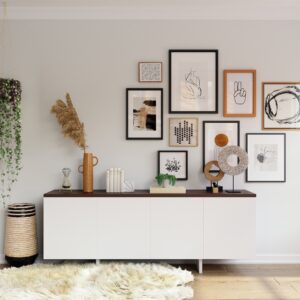
Thrift Store Treasures
One of the best budget-friendly decorating options is exploring thrift stores and second-hand shops. You’ll be amazed at the unique and eclectic items you can find, from vintage furniture to quirky accessories. Give old pieces a new lease on life with a fresh coat of paint or by reupholstering cushions. Not only will you save money, but you’ll also add character to your home.
DIY Artwork
Create personalized and budget-friendly artwork to adorn your walls. Experiment with canvas, paint, and simple crafting materials to unleash your creativity. Whether it’s abstract paintings, photo collages, or handcrafted wall hangings, DIY artwork adds a unique touch to your space and allows you to express your personality without spending a fortune.
Reimagined Furniture
Before you invest in new furniture, consider giving your existing pieces a makeover. Sanding, staining, or painting can breathe new life into tired tables, chairs, or dressers. Rearrange the layout of your furniture to create a fresh perspective in your space. It’s amazing how a little creativity can turn the old into something stylish and modern.
Swap and Share with Friends
Host a home decor swap with friends or family. Everyone brings items they no longer need, and you can exchange them for something new-to-you. It’s a cost-effective way to refresh your decor without spending a dime. Additionally, sharing items with others not only helps the environment but also fosters a sense of community.
Removable Wallpaper and Decals
Transform your walls without the commitment of traditional wallpaper by using removable wallpaper or decals. These are not only affordable but also easy to install and remove, making them perfect for renters. Experiment with patterns, textures, or accent walls to add visual interest to your space without the need for a major investment.
Clever Use of Mirrors
Mirrors are budget-friendly decor staples that can instantly make a room feel larger and brighter. Hunt for decorative mirrors at thrift stores or discount retailers. Arrange them strategically to reflect light and create the illusion of more space. Mirrors also add a touch of sophistication to your decor without the hefty price tag.
Budget-Friendly Textiles
Swap out throw pillows, blankets, and curtains to give your space a quick and affordable facelift. Clearance sales, discount stores, and online marketplaces often offer a variety of budget-friendly textiles. Experiment with different textures, patterns, and colors to find combinations that breathe new life into your home.
Indoor Plants on a Budget
Bringing nature indoors is an excellent way to enhance your home decor. Visit local plant sales, or propagate plants from friends to build your indoor garden without spending much. Thrifted or DIY planters can add a personalized touch. Not only do indoor plants improve air quality, but they also add a refreshing and vibrant element to your home.
Lighting Makeover
Upgrade your lighting fixtures without spending a fortune. Thrift stores often have unique and affordable light fixtures waiting to be discovered. Alternatively, give your existing fixtures a makeover with a coat of spray paint or new shades. Creative lighting can dramatically change the ambiance of a room, providing an instant and budget-friendly facelift.
Functional Wall Shelves
Install budget-friendly wall shelves to both enhance your decor and increase storage space. Look for simple, modular shelving units that you can easily install yourself. Use these shelves to display books, plants, or decorative items. Not only do they serve a practical purpose, but they also add a stylish element to your walls.
In conclusion, decorating your home on a budget requires a mix of creativity, resourcefulness, and a willingness to think outside the box. By incorporating these budget-friendly home decorating ideas, you can revitalize your living space without straining your finances. Remember, it’s not about how much money you spend but the thoughtful and creative ways you transform your space into a comfortable and stylish home.
Things to Consider Before Choosing Crane Hire For Your Home Renovation Project
Are you planning to undertake a home renovation project and do you require at least 2 cranes for the entire project in Brisbane? Or do you already have cranes at home and now you need to hire them for a home renovation project? In both cases, do not worry because you can always get a crane hire for your home renovation. But before hiring cranes, you should know the main types of cranes available so that you could choose the right one for your project.
The first type of crane is the mobile crane that can be easily dragged around and can be used anywhere and at almost any place. It comes in different sizes and is highly mobile. The best thing about this crane is that it can be assembled and disassembled at any time and then assembled again at the specified location. This means that the crane hire companies offering mobile cranes are always ready to provide new ones as and when the old ones get damaged or obsolete.

Secondly, the pole crane is another great choice of mobile crane that can easily be assembled and disassembled at the required place. It too is portable and highly reliable. There are various types of pole cranes such as boom cranes, pike cranes, telephone cranes, etc. The best part about mobile boom cranes is that they can be assembled on flat ground and disassembled on fields. In fact, these cranes are extremely useful when there is no space for transporting the crane from its storage area to the construction site.
The third type of crane is the inflatable crane which is very handy and convenient to use. It can be used anywhere and can be assembled and disassembled anywhere without disturbing the environment. When used for home renovation projects, the owner can easily move the crane into the desired location without any difficulty. Thus, it becomes all the more essential to choose the right type of crane that is most suitable for the home renovation project.
Once you have chosen the type of crane that is most suitable for your home renovation project, you also need to consider the safety features that are incorporated in the crane. Usually, better-quality cranes have been designed with safety features like breakaway systems, high fences, and strong cages. These safety features prevent any accidents and further damages to the home and property. Moreover, the other features that are necessary for the home renovation project include an emergency stop button, seat belt, rope to tow system, steps to raise/lower home, and much more.
You should also make sure that you get the right service provider when it comes to crane hire solutions for your home renovation project. The provider should be well established and reputable and has a good track record. Ideally, you would also want to go for the cheapest option but this is not always possible as there are many crane rental services available in the market. Thus, it is important to carefully identify the right home renovation project that needs a crane so that you can get the best possible deal.
How to Decorate Indoor Air Conditioners
Many people have now learned how to decorate indoor air conditioners in their homes. While this is a fairly easy task, it is often overlooked by the homeowner. It is best to first understand the basics of air conditioning before you tackle this project. This will make your life much easier when it comes time for you to plan out your design. Air Conditioning is a great way to cool down the temperature in a large room but there are also many other benefits as well. Learning how to decorate air conditioning rooms is beneficial because these rooms will look better, last longer, and cost less money to run than if you didn’t use air conditioning at all.
There are many ways in which you can use your air conditioner in the interior design of your home. First off, this device can be used to cool down your living room or den to keep from overheating. This is something that you will need to learn how to decorate an air-conditioned room on your own but if you already have some knowledge you can always ask an expert if you are at a loss. You might find yourself pleasantly surprised at the many choices and styles that are available for your air conditioning needs.
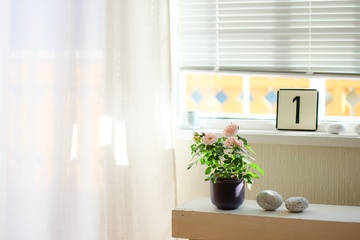
Another way in which air conditioners can be used in the design of your home is to help you create a more serene environment. It is quite common for people to suffer from stress and having a room that is comfortable can help you to relax more easily. There are many different styles of air conditioners that can be used in the interior design of a room. Most people are interested in purchasing a unit that is both stylish and affordable. If you live in a small apartment or house, this is a good choice as you will not have to worry about cooling your entire room. If you have a large home or condo however you may want to consider investing in a model that offers both options for a more affordable price.
You can also find air conditioners that can be placed directly into your wall. These units are ideal for rooms that are rather dark or have a very futuristic look to them. You can have your air conditioner mounted on the wall or you can purchase an invisible version that can be concealed under a rug or other covering. These units can also be used in a bathroom that has a high ceiling. Because these units cool so much they can easily be placed in the middle of the room and left there for several hours at a time without any noticeable effect on the room.
One of the most common ways to decorate an air conditioning unit is with the use of color. This is because it is known that colors affect our moods and emotions. You can choose to have your air conditioner either rest behind a color that matches the walls or you can opt for something that stands out and draws attention to the unit. If you are looking for a way to add some drama to your home, consider having a mural painted on one of the walls of the room that you would like to cool.
While it may take a bit of work to learn how to decorate indoor air conditioners, they are a worthwhile investment. Your home will be more comfortable and pleasant when you take the time to properly cool and heat the area in which you live. This will not only improve the quality of your life, but will also make your home safer and more appealing.
Master Bedroom Makeover
 They say that the boudoir should be a temple, an oasis of calm set apart from the commotion of the rest of the house. But all too often, the chaos of everyday life creeps into the master bedroom, leaving in its wake a jumbled, cluttered look that is neither pleasing to the eye nor relaxing. Does this sound familiar? Well, take heart, because, in just a few easy steps, you can reclaim this space and create your own unique zone of privacy and relaxation. Here are three styles that can instantly up your master bedroom’s calm quotient.
They say that the boudoir should be a temple, an oasis of calm set apart from the commotion of the rest of the house. But all too often, the chaos of everyday life creeps into the master bedroom, leaving in its wake a jumbled, cluttered look that is neither pleasing to the eye nor relaxing. Does this sound familiar? Well, take heart, because, in just a few easy steps, you can reclaim this space and create your own unique zone of privacy and relaxation. Here are three styles that can instantly up your master bedroom’s calm quotient.
- Contemporary: If you want a sleek, contemporary master bedroom, what you take away matters even more than what you keep in the room. Remove all extraneous clutter, invest in a few pieces of dark-toned furniture with clean, angular lines, and choose a muted, modern color like celery green for the walls and accent with blacks, grays, and silvers. Wall art should be simple but striking, with an emphasis on geometric planes and angles.
- Southwestern: Bring the feel of the rustic West into your bedroom with a color palette of muted rusts and earth tones that reflect the vast landscape of the region. Use a sunny yellow or warm terra cotta for the walls, select a few pieces of furniture made from rough-hewn, medium-toned wood, and bring a few of the heavily textured Native American textiles for floor coverings or wall art. Copper accents and natural elements such as dried flower wreaths complete the look.
- Asian: The simplicity of this look makes it a perfect match for a master bedroom. Choose a wall coloring of the palest jade green, add bamboo blinds as window treatments, select a clean-lined black or dark-wood bed, and use a few red silk pillows as an accent. For art and accessories, incorporate a few ethnic pieces from your local import store to add authenticity. A small tabletop fountain can serve as the finishing touch.
Home Theaters Big Ideas
The home theater is a relatively new concept in home decorating. Today, many families prefer to keep a separate room for televisions, flat-panel monitors, DVDs, video game systems, and other entertainment media, thereby allowing the living room to remain a quiet space for relaxing activities. However, just because the home theater room is designed for a very specific purpose, that doesn’t mean that you have to stick with a simple, utilitarian design. Instead, think of it as your own personal canvas for adding to the entertainment value of the room. Here are a few ideas to inject even more fun into your home theater.

- Wild West: Do you have a fan of Western movies in your household? Use your media room as a place to fully explore this style with a bit of tongue-in-cheek irreverence. Use a light tan on the walls to emulate the desert landscape, choose saddle-tone leather for your theater seating arrangement, and cover the walls with Western kitsch and collectibles. A simple coiled rope makes a great lasso display, and a pair of bull horns will serve as a great focal point over the main television.
- Super-Sleek Contemporary: If you are a gadget lover whose home theater is chock full of the latest in high-tech media components, it may make the most sense for you to create a look that builds upon, rather than tries to hide, the plethora of silver boxes that probably dominate the room. Choose black seating, furniture with straight lines, a mid-tone gray for the walls, and lots of silver and/or glass accent pieces. For artwork, stick with simple, geometric shapes in a limited palette. Create interest with different textures, repetition, and unified displays of mono-toned collections of objects.
- The Silver Screening Room: Another popular concept for the home theater is creating décor that is an homage to the cinema. The best type of seating for this room is the commercially available home theater recliners, but rows of any type of comfortable black or dark-toned chairs will also suffice. A rich burgundy or navy blue on the walls will help recall the grandeur and glamour of Old Hollywood. Use a heavy, long fabric in the same deep tone as a window treatment with gold rope accents. Art ideas include old movie posters and other movie paraphernalia, film spools and other projection equipment, star motifs, and wall letters or signs that emulate the look of a marquee.
Guest Rooms Design Ideas
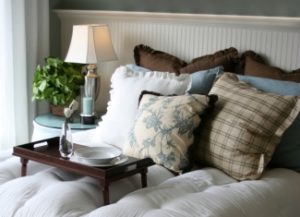 In the past, the guest room often looked very much like the afterthought that it was: a hodgepodge of leftover furniture and odds and ends that hopefully allowed enough room for visitors to sleep. Today, the trend is focused on creating guest rooms that showcase hospitality and concern for your visitors’ comfort and convenience. At the same time, many guest rooms have to do double duty, serving as an office, craft room, or storage space after the visitors have gone. Think of it as your own mini-suite at a welcomingly cozy bed ‘n’ breakfast to do with what you will, but don’t forget to add practical considerations such as under-bed storage to your design plan. Here are some style suggestions for your guest room redesign.
In the past, the guest room often looked very much like the afterthought that it was: a hodgepodge of leftover furniture and odds and ends that hopefully allowed enough room for visitors to sleep. Today, the trend is focused on creating guest rooms that showcase hospitality and concern for your visitors’ comfort and convenience. At the same time, many guest rooms have to do double duty, serving as an office, craft room, or storage space after the visitors have gone. Think of it as your own mini-suite at a welcomingly cozy bed ‘n’ breakfast to do with what you will, but don’t forget to add practical considerations such as under-bed storage to your design plan. Here are some style suggestions for your guest room redesign.
- Transitional: While other rooms allow you a chance to express yourself, this room should be designed with your guests in mind. A simple, soothing transitional look may be the best bet to let your guests relax in style. Choose café au lait-colored walls, warm, mid-toned furniture with clean lines, and a dark brown or off-white duvet cover or comforter. Wood blinds paired with a simple pair of tab top curtains will provide privacy and style. Choose dark iron light fixtures or accents if you want a more traditional look, or silver accents if you have a more modern style in mind. Simple framed artwork in a muted palette will unify the room.
- Shabby Chic: This increasingly popular look brings the garden indoors with simple retro charm. Choose white painted or wicker furniture, light pastel green or blue on the walls, and vintage or vintage-look accents and art. The fun part is scouring thrift stores for unique accents; just make sure that most of your finds are in the same color family so that the combined impact isn’t overwhelming. Light fixtures with suspended crystal pendants make a dramatic statement, especially when contrasted with a lightweight, sheer window treatment. As a finishing touch, antique ceiling tins make great wall art.
Dining Room Decor Ideas
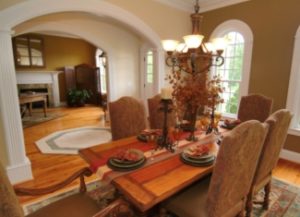 Whether it’s a formal dinner party or a casual weekday morning breakfast, the dining room is usually thought of primarily as a venue for chowing down. But you don’t have to skimp on style just because the dining room usually hosts only eating-related activities. A versatile style is best for this space; plan on a look that can be easily dressed up for company with the addition of a few choice accessories and made more informal during the week by setting some of the extra knickknacks and accents in a drawer. Need some inspiration? See if any of these ideas spark your imagination!
Whether it’s a formal dinner party or a casual weekday morning breakfast, the dining room is usually thought of primarily as a venue for chowing down. But you don’t have to skimp on style just because the dining room usually hosts only eating-related activities. A versatile style is best for this space; plan on a look that can be easily dressed up for company with the addition of a few choice accessories and made more informal during the week by setting some of the extra knickknacks and accents in a drawer. Need some inspiration? See if any of these ideas spark your imagination!
Mediterranean: This subdued but comforting look is the perfect match for a dining room. Begin with a simple faux finish on the walls using gold tones, designed to emulate the look of fine plaster in a Tuscan villa. Supplement with rich floral fabrics and window treatments in mid-range corals and greens. If you have artistic talent, you can decorate the walls with simple floral or ivy patterns (stencils are a great option for this, too). Keep the lighting low and indirect to preserve the mood in the room. Dark iron accents complete the look.
Contemporary Asian: Because dining rooms require a few pieces of furniture, it is easy to achieve the streamlined look this style requires. Use a cream wall color to keep the backdrop simple. Select clean-lined pieces in a very dark wood tone. Bring in natural textiles as window treatments, such as bamboo blinds. A dark-colored Oriental rug is an obvious choice underfoot, and dark red accents will provide an interesting counterpoint. Asian-inspired accents will unify the look.
Paris Style: Bring the sophistication and charm of the French capital into your dining room with a few small touches. Select a mid-tone dinette set with rounded lines, and choose paint and textiles in several shades of coffee and caramel brown. Use semi-structured curtains in a heavy fabric in chestnut brown or rust. Gold accents, Impressionist artwork, and a few contrasting splashes of dark red will tie the look together.
Kitchen Decorating Ideas
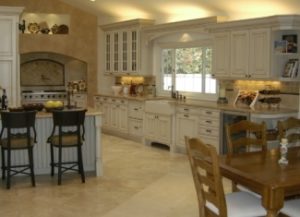 They say the kitchen is the heart of the home, and with good reason. Did you ever notice how gatherings of people always migrate there? You may have your formal rooms decorated to the nines for a New Year’s Eve party, but inevitably, everyone will end up trading banter and laughs around the kitchen counter. All told, you probably spend more time in this room than in almost any other, so why not make it look as appealing as it smells when you’re whipping up a delicious dinner? Maybe one of these kitchen décor ideas will work for you, or maybe you can spice one of them up with your own secret ingredients.
They say the kitchen is the heart of the home, and with good reason. Did you ever notice how gatherings of people always migrate there? You may have your formal rooms decorated to the nines for a New Year’s Eve party, but inevitably, everyone will end up trading banter and laughs around the kitchen counter. All told, you probably spend more time in this room than in almost any other, so why not make it look as appealing as it smells when you’re whipping up a delicious dinner? Maybe one of these kitchen décor ideas will work for you, or maybe you can spice one of them up with your own secret ingredients.
- Transitional: This style has gained increasing popularity in kitchens over the last several years. Transitional style, if you’ll remember, combines both contemporary and traditional elements to achieve a cozy yet modern compromise between these two styles. The transitional kitchen is characterized by mid-tone woods with clean lines, stainless steel appliances, and accents, granite or granite-look countertops, and a warm earth tone such as rust or gold on the walls. Complete this look with simple framed artwork in complementary colors and tailored unfussy window treatments.
- Tuscan: If the Mediterranean region of Italy inspires you, there are few spaces as welcoming as a Tuscan-look kitchen. Choose a warm terra cotta color for the walls, using a faux finish to emulate the look of plaster if possible. Cabinets and furniture can be a warm mid-tone wood or painted white. Bring the look of the earth into the room with natural materials such as marble or ceramic floors and countertops. Accents should be earthy, with the colors purple and green highlighted to reflect the influence of wine production in the Tuscan region. If you’re ambitious, a hand-stenciled ivy wall border is a great accent idea. Complete the look with artwork depicting primitive Italian scenes.
- Country: Does a down-home, traditional look appeal to you? Today’s country kitchens are a far cry from the frilly, dowdy looks that dominated this style genre in the past. Approach the style with a pared-down, spare aesthetic in mind. Furniture should be mid-toned wood with clean lines in the Shaker style. For cabinetry and accents, try a muted milk-paint tone of blue or red, with walls painted in a lighter tone from the same color family. Ceramic tile countertops make an interesting, user-friendly style statement. Choose wall art that reflects the style, with prints and accents depicting roosters, vegetables, and outdoor scenes. Simple, lightweight window treatments add a finishing touch.
Bathrooms Design Ideas
One of the most notable trends in home décor in recent years has been the incredible expansion in the size of the average residential bathroom. In the past, bathrooms were often tiny spaces with barely enough room to take care of your daily hygiene routine without banging into the wall. Today’s bathrooms are expansive, with a design that reflects a renewed emphasis on allowing those who enter it a much-needed respite from the whirlwind of twenty-first-century life. Don’t have the budget for renovations? No problem — you can introduce a soothing note of serenity with just a few simple changes. Look over these ideas to help you find bathroom bliss.

- Spa Style: Don’t feel like you can’t create the feel of a spa bathroom without a huge remodeling budget. By creating a minimalist, relaxing space and adding a few key accents, you’ll be relaxing in no time. Choose a clean, muted color such as a light sage green for the walls. Select dark-toned wood for your cabinetry and storage furniture, with simple wood blinds as the window treatment. Ceramic or even vinyl tile in a muted earth tone complements this look. To maintain a sense of serenity, limit the amount of wall art and accent pieces. Plush white towels, linens, and bathrobes complete the look.
- Art Deco: If you live in an older house, it may be best to try to capitalize on the unique charm of the existing space rather than starting anew with drastic renovation. The sleek, streamlined art deco look reflects the unique charm of the 1920s and works well in a smaller space. Key ingredients include a beveled pedestal sink, black and white ceramic or hex tile on the floors and, if possible, the walls, and lots of gleaming mirrored, nickel, and white surfaces. Use wall art and accents in bold black with a geometric, streamlined look. If you prefer a contrasting wall color, pink or salmon also works well with the deco style.
How To Effectively Irrigate Your Yard For A Nice Lawn
Smart homeowners are always looking to improve their home. Sometimes the wish list can be a mile long, but the pocket book can be a dollar short! So, just how does one achieve the goal of updating their home on a budget? Learn from what others have found out from experience! You’ll be surprised to learn that home improvements don’t have to cost a fortune. Let’s take a look at a few tips for improving your home on a budget.
An easy and cost effective way to spruce up your home is by painting the interior. To estimate the amount of paint you need, you have to calculate the square footage of the walls. Simply multiply the length of the wall by its height. One gallon of paint will cover approximately 350 square feet. Bear in mind that you may need two coats of paint, depending on what color you are painting over.
If you have water leaking from the top of the tap of your faucet, there are two ways you can solve this problem. First try tightening the gland nut. The gland nut keeps the spindle of the tap in place. If this doesn’t work, try replace the rubber seal on the spindle, also known as the O-ring.
If you have a lot of dirt in your backyard or garden, you can easily make your own pathways using pavers and stones. You don’t need to use any concrete, just lay your stones in a nice design or pattern in the area you need it to cover. This can provide a nice and balanced look to your garden, as well as keeping your shoes dirt free.
Is it cheaper to do it yourself or pay someone else? If you decide to completely re-do your bathroom, but know nothing about plumbing, it might be beneficial to pay a plumber to come in. Also, you can check out the self help books at your local building supply. Don’t be afraid to ask. A simple project shouldn’t cost more because of inexperience.
Do you want to gain a little closet or floor space in your next home improvement project? Relocate your water heater to your attic! Modern water heaters are produced in efficient, reliable “low-boy” designs that you can tuck safely between your ceiling and your roof. This allows you to gain a little extra storage space.
Gutters are often the culprit in drainage problems, especially if you have had a particularly rainy season. Gutters that wet the exterior walls instead of carrying water away from them can lead to the occurrence of basement leaks. To prevent this, clean your gutters regularly.
To improve your bathroom’s appearance, try using a new glaze. Fresh glazing can transform an old bathroom. It will cost less to glaze a bathroom than it would to replace the floors and fixtures in it. A great way to improve your bathroom’s appearance is with some fresh glaze.
When looking for someone to help you with home improvements, do your research. This is important because you do not want an inexperienced or unskilled person working on your home. Ask around for a good worker from family and friends or go online and look for reviews on home contractors in your area.
Make sure that you seal the grout after you have laid the tile. Grout is very porous. If it is left unsealed, moisture will seep in, causing problems with mildew and mold. The grout will also stain. Seal the grout properly to reduce mildew and stains.
A basement is a great space to convert into a playroom, home office or gym. If your basement has at least 7 feet of head room and remains dry, the remodel should be relatively straightforward. If dampness is a problem, consult a professional to correct the issue before you begin your project.
Don’t just throw any old shingles on your roof if you need to replace those old ones. In order to keep your home cooler in the summer, go with a light-colored shingle. Lighter colors reflect the heat, while darker colors absorb it and ultimately transfer the heat to your home.
Have your chimney cleaned and inspected prior to using your fireplace each year. The inspector can look for creosote build-up, cracks in the lining, nests from animals or other problems that could spell disaster. A chimney sweep will use long brushes to thoroughly clean your chimney and remove debris that could catch on fire.
Improving your home is important, and even on a tight budget, it can be done! In this article we have discussed some of the tips most often recommended for updating your home. Take a weekend and give a few of these tips a try! You’ll be pleasantly surprised by what you’re capable of doing on a budget.


